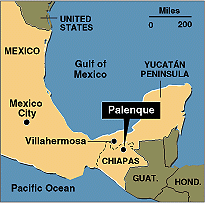

MEXICO CITY --
In rain forests at the foot of the Yucatan
Peninsula, Mexican
and American archaeologists have uncovered
a monumental
art work that appears to be one of the most revealing
artifacts that
has been found from the resplendent but mysterious final
years of ancient
Mayan civilization.
While digging
through a crumbling temple at Palenque, site of some of the
most refined
Mayan ruins in Mesoamerica, the researchers came upon a
benchlike throne
more than 9 feet wide and 5 feet deep in
vermillion-painted
limestone, which one of the last Mayan rulers built
about A.D. 760
to dazzle his subjects and convince them of his
god-given right
to power.
| What became of the Classic Mayans, who developed the only pre-Colombian writing in the Americas and devised an intricat astronomy to chart the movements of the heavens, is one of the great puzzles of archaeology. During the ninth century, flourishing cities like Palenque were abruptly abandoned, in what seems from the record of the ruins to have been a cultural collapse. |  |
The Palenque
throne is adorned with at least 200 heiroglyphs and six
sculptured portraits
that, based on the experts' first reading, disclose the
achievements
and illusions of the Mayan nobility in the decades just
before their
demise.
The discovery
also signifies a high point of cooperation between Mexican
and American
archaeologists, after a long period in which Mexico was
uneasy about
foreigners' digging in its pre-Hispanic sites.
To show Mexican
enthusiasm for the find, President Ernesto Zedillo flew
to Palenque
on Wednesday to display the partly excavated throne.
The Palenque
explorations are in the hands of a team led by Arnoldo
Gonzalez Cruz
of the National Institute of Anthropology and History in
Mexico City
and Alfonso Morales of the University of Texas at Austin.
The project
is largely financed and directed by the Pre-Columbian Art
Research Institute
of San Francisco. An art historian, Merle Greene
Robertson, directs
the institute.
"We're working
as a group," said Morales, who has been keenly aware
of Mexican sensitivities
about the excavation. "No one can say, 'This is
my throne, that
is my temple."'
Mexican authorities
suppressed all public discussion of the find for weeks
to allow Zedillo
to announce it.
Morales said
the grandeur of the throne and the spaciousness of the
palace that
houses it indicate that the last rulers of Palenque were more
ambitious and
proud of their power than had been understood. The
palace, decorated
with fine stucco carvings, is even larger than another
structure that
had been considered the central palace at Palenque.
Down zigzagging
stairways that lead into the heart of that palace, a
Mayan king named
Pakal built a mausoleum for himself covered with
delicate carvings
and inscriptions aimed at enhancing his historical
reputation.
The tomb has long been considered one of the greatest works
of Mayan artistry.
The newly found
throne belonged to a monarch descended from Pakal
and is part
of what is emerging as a construction program by later rulers
even more extensive
than that of the vainglorious Pakal. The throne
carries more
inscriptions laden with more historical information than any
other in the
Mayan world, archaeologists said.
Morales and other
experts believe that mapping the grandiose building
projects could
be crucial to reaching a new understanding of the Maya
decline. The
scientists have theorized that the logging required to sustain
the stucco construction
may have depleted forests and compounded
ecological changes,
perhaps undermining agriculture and forcing the
Mayans to migrate
to less hospitable territory.
Copyright 1999 The New York Times Company